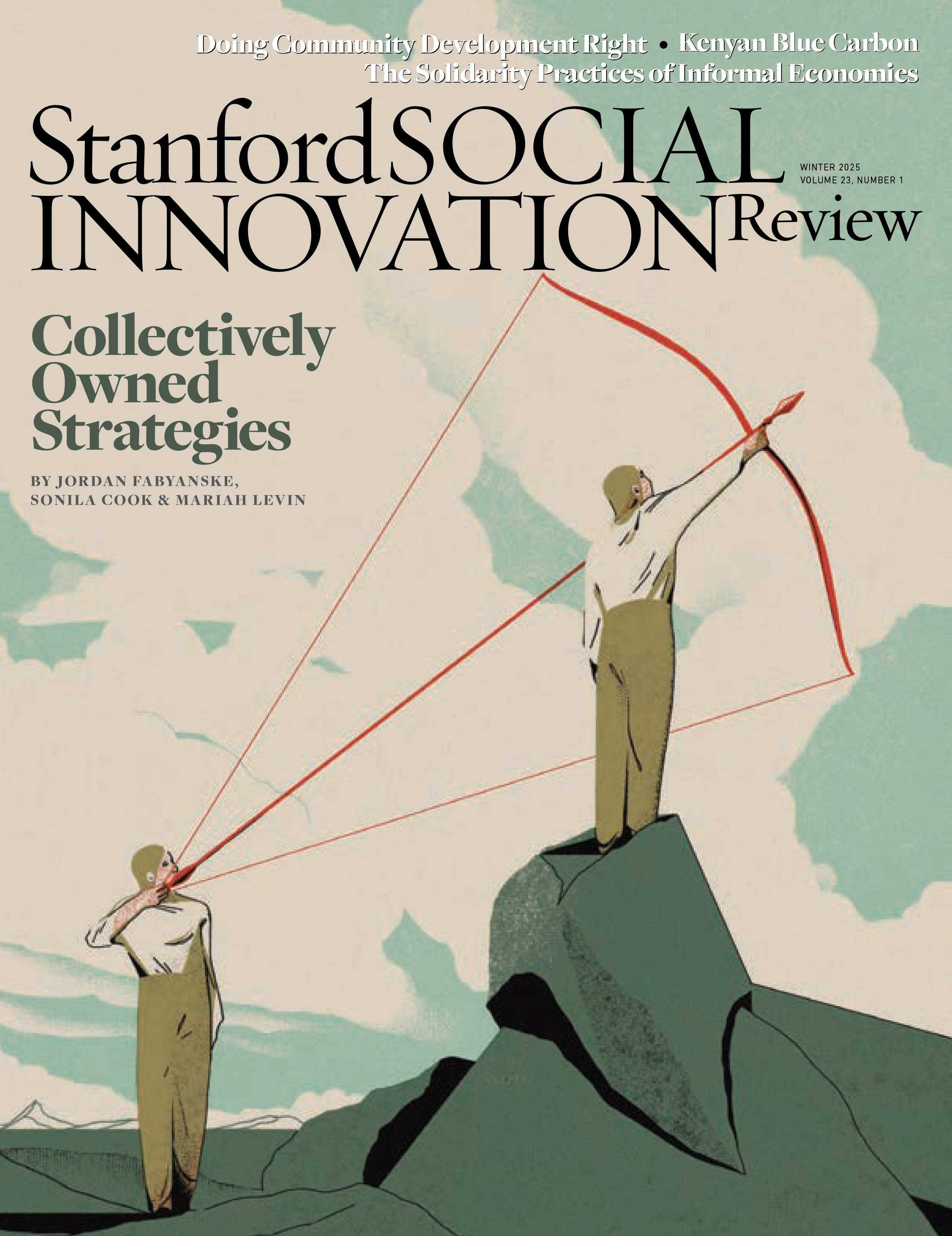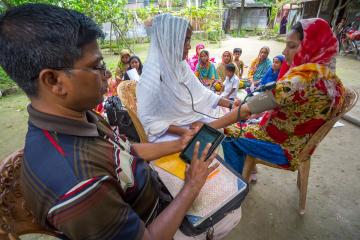
Project AI Evidence (PAIE)

Artificial intelligence has the potential to transform our lives. It is a general purpose technology that spans sectors and is widely accessible—in reach of anyone with a smartphone—and is constantly improving.
But as the AI technical revolution unfolds and AI makes its way into many more social programs, there is very little rigorous evidence on where and how AI can have an impact on social outcomes. Without such evidence, companies, social innovators, and regulators lack the information to maximize the benefits of AI while protecting against its downsides.
With support from Google.org, PAIE (pronounced π, or pi) provides an unparalleled opportunity to rigorously study how these technologies can help—or harm—the well-being of people, particularly people who experience poverty. This is especially important given the speed, scale, and potential reach of many of the applications being rolled out. As AI begins to be employed across the social sector, randomized evaluations of AI applications will help us understand the most effective and least harmful approaches.
Through PAIE, researchers across J-PAL’s network work with nonprofit organizations worldwide. PAIE also collaborates with Schmidt Sciences to study the impacts of generative AI in the workplace, particularly in lower- and middle-income countries.
Funding Partners

|
Key Facts
About Project AI Evidence
PAIE works with researchers, policy partners, and AI solution developers to:
- Determine key innovations where AI is most likely to have the maximum social benefit based on more than two decades of our research across multiple sectors.
- Identify and support innovative organizations to use AI to advance social good.
- Fund rigorous research to measure the impact of AI solutions in priority areas.
- Scale and apply socially-beneficial AI solutions based on learnings from the research.
- Create and widely share a practical guide on “evaluating AI” to inform the wider research ecosystem on new methods and best practices for evaluating AI-based programs.
- Build capacity of researchers, governments, social enterprises, and NGOs to better incorporate and evaluate AI for social good.
While we are interested in AI's application in every sector, we anticipate that a lot of innovations will initially come from sectors that are seeing rapid AI adoption and/or likely to be most affected by AI, including education, health, labor markets, climate, and financial inclusion.
PAIE Team
Sendhil Mullainathan, Peter de Florez Professor at MIT with Dual Appointment in Economics and Electrical Engineering and Computer Science (EECS), serves as PAIE's Scientific Advisor.
Staff
- Sam Carter, Senior AI Policy Manager
- Jack Cavanagh, Research Manager
- Katie Chen, Policy Manager to Global Executive Director
- Attaullah Abbasi, Senior AI Policy Associate
- Audrey Lorvo, AI Policy Associate
Other Resources on AI for Social Good
In the Stanford Social Innovation Review, J-PAL's Iqbal Dhaliwal, Global Executive Director, and Michael Hou, Senior Policy Associate, discuss five paths with the highest potential for AI to increase program effectiveness, and how rigorous impact evaluations can help maximize AI's benefits while mitigating its risks. Read more »

Public Talks on Artificial Intelligence
Iqbal Dhaliwal discusses AI in the social sector at the 2024 World Economic Forum in Davos.
A panel discussion on “AI: Emerging Challenges and Opportunities” at J-PAL’s 20th anniversary event at MIT in 2023 brought together thought leaders to discuss the likely impacts of evolving AI technology on social and economic issues including productivity, growth, and labor markets.
Panelists included David Autor, Ford Professor of Economics, MIT; Iqbal Dhaliwal, Global Executive Director, J-PAL; Gita Gopinath, First Deputy Managing Director, IMF; Brigitte Hoyer-Gosselink, Director of Product Impact, Google.org; and S. Krishnan, Secretary, India Ministry of Electronics and Information Technology.
J-PAL signs its first dedicated AI MoU in Hyderabad, becoming the research and evaluation partner for the Government of Telangana's AI work. On stage, Iqbal Dhaliwal and Aditi Namdeo greet dignitaries of the Government of Telangana.
Iqbal Dhaliwal joined a panel at the Mastercard Impact Data Summit 2024 on "Pioneering inclusive AI: Expanding the field of impact data and AI" in September 2024. The panel discussed the critical roles of AI and data in driving social impact.
Evaluations of Artificial Intelligence and Machine Learning
Economic opportunity and jobs
- In France, Bruno Crepon and coauthors published a working paper investigating a job recommender system that uses machine learning to improve matches for job seekers.
- In Kenya, David Atkin, Antoinette Schoar, and coauthors partnered with a data annotation company for machine learning algorithms to measure both the impact of their AI 101 training program and this training program plus job referrals on workers.
- In the US, Peter Bergman and coauthors are evaluating the impact of LLM-based coaching for underrepresented job applicants on job search and salary negotiation.
- Also in the US, Peter Bergman is evaluating the impact of an LLM-based chat-agent during the hiring process to assess its impact on demographic disparities in hiring.
Health
- In India, Esther Duflo, Frank Schilbach, co-researchers, and J-PAL South Asia are collaborating with the Government of Tamil Nadu to develop and evaluate a machine learning tool to improve health screening for the elderly: leveraging data from 30,000 diagnostic tests to create less expensive, predictive mobile tests for home use.
- Also in India, J-PAL is in the early stages of collaborating with Wadhwani AI to develop an AI solution for estimating the weight of a baby using smart phone photos and/or video.
- In Kenya, Jessica Cohen, Margaret McConnell, and coauthors partnered with Jacaranda Health to evaluate the impacts of an AI-supported mobile health platform for pregnant and postpartum people on their care-seeking behavior and health outcomes.
- In the US, J-PAL's Health Care Delivery Initiative is funding a project led by Manuela Angelucci and other researchers, who are collaborating with an NGO to develop and evaluate an AI-based mental health mobile app to provide mental health support to immigrants in the US.
Climate change and agriculture
- In Colombia, Santiago Saavedra and coauthors have used AI tools and satellite imagery to detect illegal mines in Colombia to protect people and natural resources.
- In India, J-PAL's King Climate Action Initiative is funding a project led by Rohini Pande and Maulik Jagnani, who are collaborating with Google’s Flood Forecasting initiative to conduct the world’s first randomized evaluation of a flood early warning system paired with community outreach and measuring impacts on behavior, health, and economic wellbeing.
- Also in India, J-PAL's Agriculture Technology Adoption Initiative, Cash Transfers for Child Health Initiative, and King Climate Action Initiative are funding a project led by Kelsey Jack, Seema Jayachandran, Namrata Kala, Rohini Pande, and coauthors who are using machine learning and satellite data to measure the impact of Payment for Ecosystem Services (PES) contracts to avoid crop burning in India (a key contributor to poor air quality).
- In Kenya, J-PAL's Digital Agricultural Innovations and Services Initiative is funding a project led by researchers who are collaborating with Nuru, an AI-enabled mobile application that helps smallholder farmers diagnose and treat plant pests and disease.
- In Peru and Brazil, Alipio Ferreira is using AI to improve satellite enforcement of crop-burning and deforestation regulations in Peru and Brazil. He is working with J-PAL’s Latin America and the Caribbean (LAC) office and Innovations for Poverty Action (IPA) to build an embedded lab within Peru’s Ministry of Environment.
- In the US, Rob Metcalfe is collaborating with real estate companies to evaluate the impact of providing fire risk information to California homebuyers on their housing decisions.
- Also in the US, Michael Greenstone and coauthors are using AI to predict and detect and reduce pollution through improved regulatory enforcement with the US EPA and Colorado.
Education
- In Brazil, Bruno Ferman and coauthors found that an AI-powered educational tool that scored students’ essays enabled teachers to provide more frequent individualized feedback to students, resulting in improved essay scores.
- In Canada, J-PAL's Social Policy Research Initiative is funding a project led by Phil Oreopolous, who is conducting a randomized evaluation to study the impacts of AI-powered tool “Khanmigo,” a personalized tutor designed to support student’s progress with Khan Academy assignments.
- In India, Rocket Learning, an organization at which J-PAL Global Executive Director Iqbal Dhaliwal serves as a board member, is leveraging machine learning and generative AI to create customized content and learning paths for children to help teachers and anganwadi workers develop lessons.
- In South Africa, Cally Ardington is developing an AI-based voice recognition model that performs early-grade reading assessments in African languages.
Finance
- In Egypt, Gharad Bryan, Dean Karlan, and Adam Osman used machine learning in a randomized evaluation to analyze psychometric data on loan borrowers. The model accurately predicted which borrowers would be “high-performing” and “low-performing,” in terms of their returns on a large loan.
Other research
- Daron Acemoglu and David Autor are leading thinkers regarding how AI will impact labor markets. Their paper studied the relationship between AI adoption and job vacancies in the US, and the role of workers' skills when AI is implemented in organizations.
- Jens Ludwig is harnessing data science to help solve social problems and helped establish both the Crime Lab and Education Lab at the University of Chicago. Jens recently coauthored a paper on machine learning for hypothesis generation and another paper on algorithmic bias.
- Christopher Neilson has investigated the impact of several AI interventions like chatbots to boost educational outcomes. He also created ConsiliumBots to leverage AI and data to help policymakers make more informed decisions.



